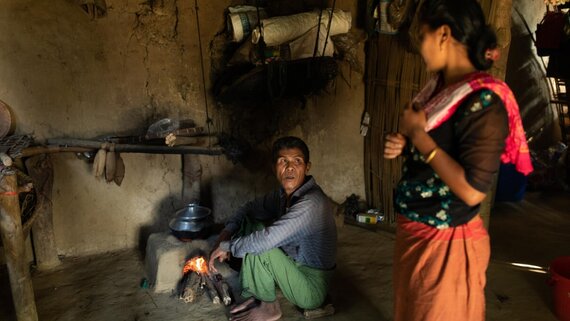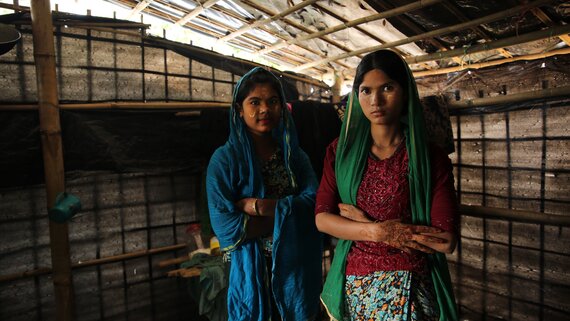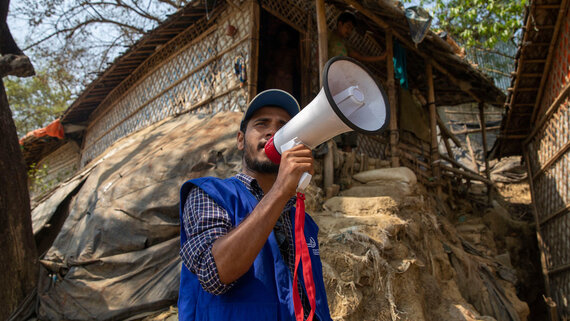Analysis of the context, crisis and needs
Bangladesh has generously provided safety to Rohingya refugees from Myanmar for several decades, most notably in the aftermath of the events of August 2017. Moving into the fifth year of the crisis in the neighbouring country, the Government of Bangladesh and the humanitarian community are providing critical support in an increasingly resource-strained environment. The humanitarian community is committed to supporting Bangladesh in leading the humanitarian response for over 900,000 Rohingya refugees until conditions allow for their return to Myanmar in a safe, voluntary, dignified and sustainable manner.
Rohingya refugees reside in 34 congested camps within Cox’s Bazar District and on the island of Bhasan Char. They are entirely reliant on humanitarian assistance. When the COVID-19 pandemic began, the Government and humanitarian actors scaled up the emergency health response and effectively curtailed its spread in the camps and surrounding areas. Rohingya refugees continue to benefit from the roll-out of the national COVID-19 vaccination campaign. However, in line with strict national COVID-19 measures for significant parts of 2020 and 2021, lockdowns resulted in a drastic reduction of activities in the camps. Similar to other situations globally, this contributed to a deterioration in the protection environment in the camps and heightened the vulnerabilities of women, children, older persons and those with disabilities.

Teknaf, Bangladesh
This Bangladeshi girl stands next to her father. She has been helping him since her mother died in 2017. She struggled to sell her crops and earn a living during last year’s nationwide lockdown. She said: “COVID also affected our production as we couldn’t find labourers to work. We suffered a lot due to the lack of income… sometimes we did not have enough to eat.” The arrival in 2017 of more than 740,000 Rohingya refugees fleeing violence in Myanmar to Cox’s Bazar had a profound impact on local communities. The influx increased pressure on already stretched public services, infrastructure and natural resources.
UNHCR/Kamrul HasanCox’s Bazar District has a Bangladeshi population of 2,650,000, approximately 514,000 of whom reside in Ukhiya and Teknaf Upazilas, where the refugee camps are located. Humanitarian operations have increased local employment and economic opportunities for local populations. However, the growing multifaceted needs of Rohingya refugees and the COVID-19 pandemic have compounded existing socioeconomic challenges, exacerbating pressures on some public services and infrastructure. In particular, multisector needs assessments indicate that host communities members report that some of their most significant needs are access to food, shelter materials and income-generating activities. To prevent potential tensions between communities, it is critical that support continues to be extended to vulnerable Bangladeshi communities.
Projected situation in 2022 and beyond
In 2022, sustained and strengthened assistance will continue to be required in areas including food, nutrition, health, safe water and adequate sanitation, education, shelter and non-food items. The Government and the humanitarian community have effectively managed the COVID-19 response until now, but the trajectory of the virus remains unpredictable. The humanitarian community will continue to be vigilant and maintain its emergency health response capacities.
The overall protection and security environment in the camps has deteriorated over the year, and this is likely to continue without a comprehensive community-led approach. Quality education, including the planned roll-out of the Myanmar Curriculum Pilot, skills development and self-reliance activities will contribute towards mitigating some of these challenges in Bangladesh while also ensuring that the community is better prepared for an eventual and meaningful repatriation and reintegration in Myanmar. Addressing the specific needs of those most vulnerable, including women, girls and boys, as well as persons with disabilities, will remain critically important.

Cox's Bazar, Bangladesh
Two sisters inside the shelter that they share with their family in Cox’s Bazar. When they arrived in the settlement at the height of the monsoon season in 2017, the all-female household had to hire day labourers to build their shelter, which is made of bamboo and thin, ripped polythene sheets. Without any money of their own they relied on private donations from Bangladeshis, who have helped many vulnerable families.
IOM/Olivia HeadonOver the years, Bangladesh has made immense strides to mitigate the loss of life and property due to weather-related hazards, such as cyclones and heavy monsoons that result in landslides, flooding and a spike in communicable diseases. The Rohingya refugee camps and surrounding areas are particularly vulnerable for a variety of reasons, including monsoon floods, fires and climate change more broadly. Building on Bangladesh’s well-established and effective disaster response capacities, efforts to scale up a multi-hazard preparedness and response capacity and to combat the impact of climate change will be essential.
Following the signing of the memorandum of understanding between the Government of Bangladesh and UNHCR (on behalf of the UN) in October 2021, efforts will also need to be stepped up to support refugee communities in Bashan Char. 2022 in particular will require critical investments to set up logistical and other systems on the island.
Response priorities in 2022
Under the leadership of the Government of Bangladesh, the humanitarian community will continue to strengthen protection and assistance for Rohingya refugees and vulnerable host communities. Five strategic objectives will guide the response across all sectors:
- Work towards the sustainable repatriation of Rohingya refugees to Myanmar, focusing on developing refugees’ capacities through the Myanmar curriculum, developing skills that will support their reintegration upon return, and strengthening community-based efforts.
- Strengthen the protection of Rohingya refugee women, men, girls and boys, placing affected communities at the centre of the response.
- Deliver life-saving assistance to populations in need, including maintaining and rationalizing services to ensure equal access to humanitarian assistance.
- Strengthen disaster risk management by improving preparedness for multi-hazard crises and addressing the impacts of climate change within the refugee camps and host communities.
- Foster the well-being of host communities, including through facilitating access to quality services, strengthening public service infrastructure and supporting livelihoods.
Rohingya JRP
A protection framework will guide the response, ensuring a focus on critical protection issues, delivery of targeted protection activities, and promoting community-led, needs-based and participatory approaches to assistance. The humanitarian response will also be underpinned by age, gender and diversity mainstreaming, disability inclusion, a comprehensive approach to protection from sexual exploitation and abuse, and enhancing community engagement and accountability to affected populations.
Climate change and environment

The Rohingya refugee camps and surrounding areas are particularly vulnerable to the effects of climate change and a variety of natural hazards, including cyclones, monsoon floods and fires, requiring a focus on enhancing multi-hazard preparedness and response capacities. In 2022, the Government of Bangladesh and humanitarian partners will step up efforts on disaster risk management, energy and environmental issues in the Rohingya refugee camps and host communities, driven by an additional strategic objective of the Joint Response Plan.
Planning for multi-hazard crises in the Rohingya refugee camps and surrounding host communities will be a key priority across sectors, requiring the development of comprehensive disaster contingency plans that are connected to national and local disaster response systems. Partners plan to bolster camp-level risk management, preparedness and response through training refugee and Bangladeshi first responders, as well as through adequate physical risk mitigation activities, including structural reinforcements, slope protection and adequate drainage systems. Efforts to mitigate the impacts of climate change and support environmental rehabilitation and protection will also be scaled up, requiring the promotion of renewable energy sources, planting and maintaining forestry restoration sites, and seeking appropriate and sustainable solid waste management systems.
In the picture, this Rohingya refugee has been working with IOM to keep his community informed following a fire at Cox's Bazar.
IOM/Mashrif Abdullah AlFurther reading
Source: IOM
Source: UNHCR



